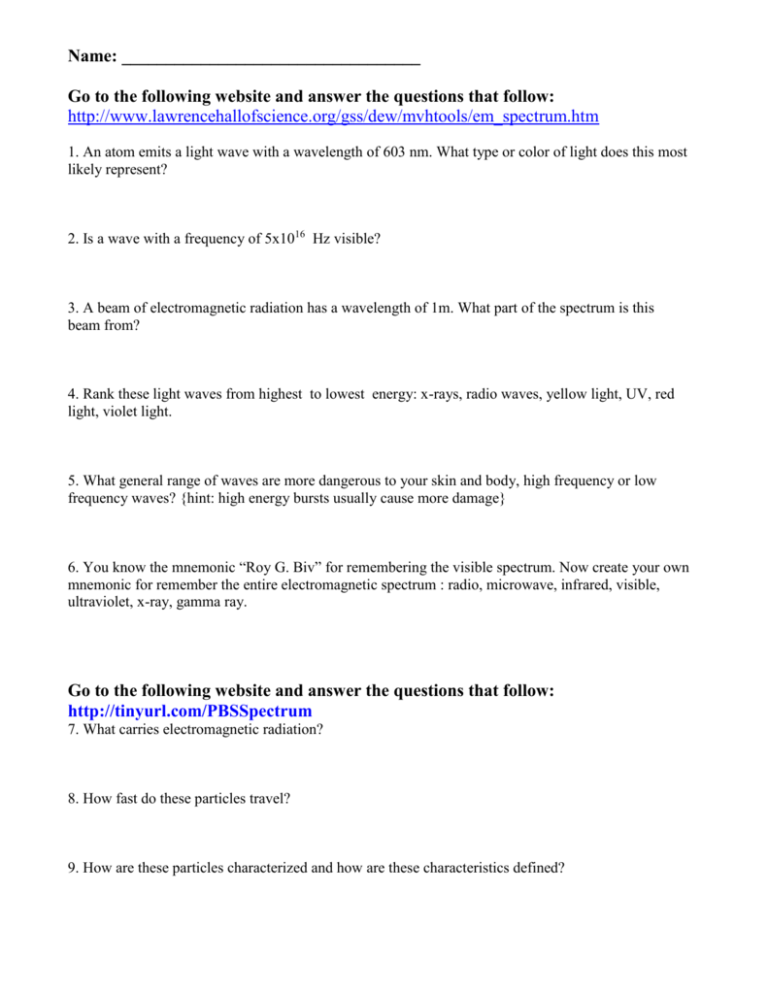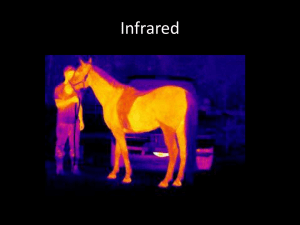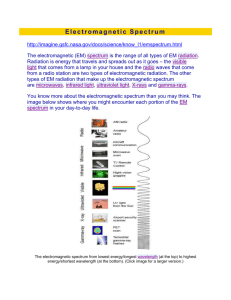1EMWebquest
advertisement

Name: __________________________________
Go to the following website and answer the questions that follow:
http://www.lawrencehallofscience.org/gss/dew/mvhtools/em_spectrum.htm
1. An atom emits a light wave with a wavelength of 603 nm. What type or color of light does this most
likely represent?
2. Is a wave with a frequency of 5x1016 Hz visible?
3. A beam of electromagnetic radiation has a wavelength of 1m. What part of the spectrum is this
beam from?
4. Rank these light waves from highest to lowest energy: x-rays, radio waves, yellow light, UV, red
light, violet light.
5. What general range of waves are more dangerous to your skin and body, high frequency or low
frequency waves? {hint: high energy bursts usually cause more damage}
6. You know the mnemonic “Roy G. Biv” for remembering the visible spectrum. Now create your own
mnemonic for remember the entire electromagnetic spectrum : radio, microwave, infrared, visible,
ultraviolet, x-ray, gamma ray.
Go to the following website and answer the questions that follow:
http://tinyurl.com/PBSSpectrum
7. What carries electromagnetic radiation?
8. How fast do these particles travel?
9. How are these particles characterized and how are these characteristics defined?
Click on “Begin the Tour” and answer the questions below.
10. How are human-made radio waves generated?
11. How is the radio portion of the spectrum divided?
Click “Next: Microwave”
12. What are the uses for microwave?
13. Why did creating microwaves pose a challenge to engineers during the 1930s?
14. How do microwave ovens heat food?
15. What wavelengths do stars emit?
16. How are we able to see pictures of the stellar objects that are in wavelengths other than visual?
Click “Next: Infrared”
17. What is infrared radiation also called?
18. Do all objects give off infrared radiation, and where does this radiation come from?
19. How is the amount of infrared radiation an object emits related to the objects temperature?
20. What happens if an object, like a radiator, continues to heat up?
21. What can you clearly make out when you look at the constellation Orion in infrared?
Click “Next: Light”
22. How much of the electromagnetic spectrum is visible light?
23. How long is the wavelength of visible light?
24. What happens when atoms gain energy then lose it again?
25. Earth’s atmosphere is transparent to what parts of the spectrum?
Click “Next: Ultraviolet”
26. What is a good source of ultraviolet light?
27. What can ultraviolet light be used for?
28. Can humans see ultraviolet? What can?
29. Why do we study the Sun in the ultraviolet spectrum?
Click “Next: X-rays”
30. Who discovered X-rays, and why did he name them like he did?
31. What is a good source of x-ray radiation?
Click “Next: Gamma Rays”
32. How are gamma rays are created throughout the universe?
33. What are some uses for gama rays?
34. Why are there not many images of astronomical objects in gamma wavelengths?
35. How long did it take to create a gamma-ray image of the entire sky as seen from earth?











